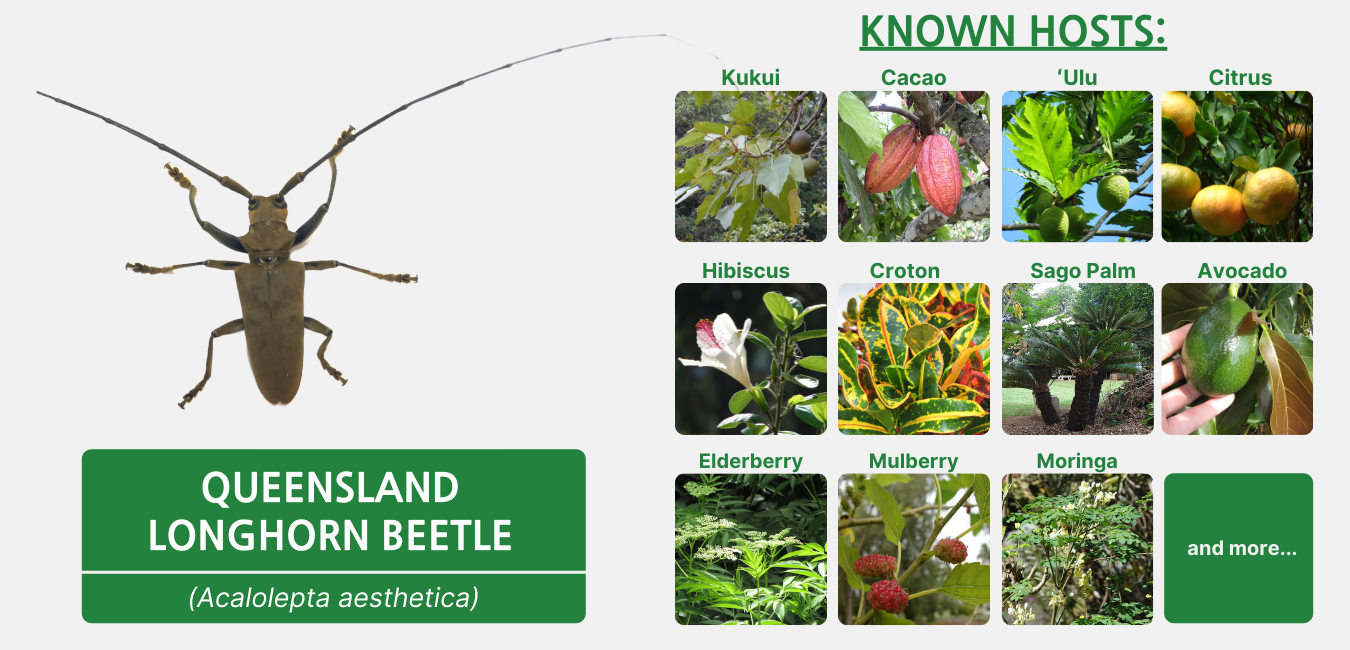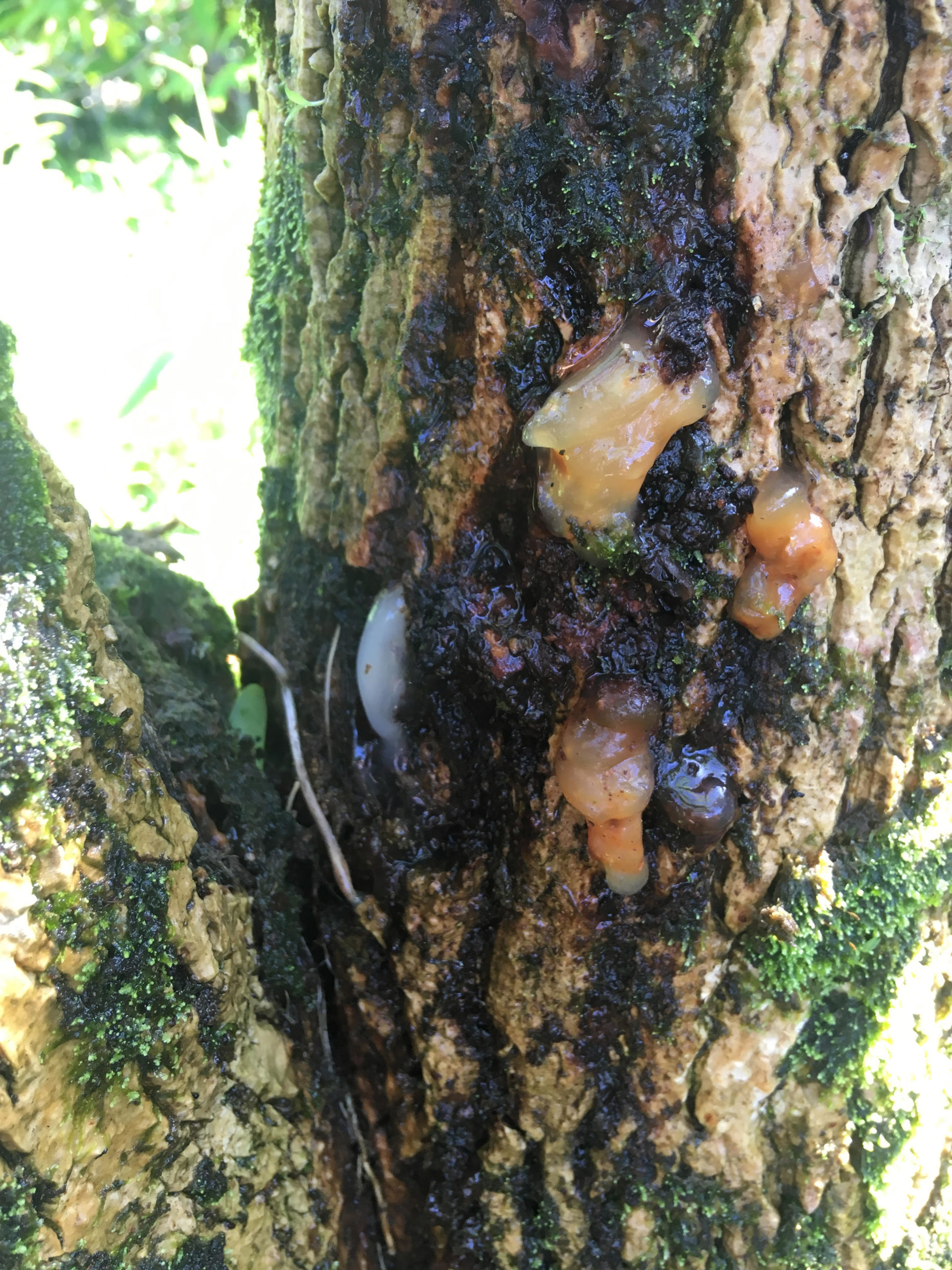
Queensland Longhorn Beetle
NOTE: QLB has only been found in limited places on the island. Please report if found outside the Hilo-Pahoa-Mountain View area.
Found a QLB? Our partners at PBARC are collecting adult QLB for research! Please drop off live beetles in a secure container at 64 Nowelo St, mauka of Komohana above Imiloa.
The Queensland Longhorn Beetle (Acalolepta aesthetica) was accidentally introduced to Puna, Hawai‛i likely through imports from Australia. Larvae tunnel through wood, weakening it and disrupting the plant’s ability to transport nutrients and water.
Larvae develop into adults within the wood and can emerge even from cut trees; chipping wood will prevent emergence. Do not move unchipped wood including to the green waste collection and landfill sites to prevent the spread of the beetle.
There is no known treatment for an infestation of A. aesthetica. Adult beetles appear to be attracted to light at night, where they can be collected. HDOA advises that routine IPM insecticidal applications may deter adult beetles from selected areas; however, research is needed to determine how to address a beetle infestation. The best strategy is prevention: be very cautious in moving potential host plant species from the infected area between Kea‛au and Pāhoa. Trees infested with larvae should be destroyed.

Description:
- 0.75 in to 1.8 in. long
- Brown, velvet-like appearance
- Long antennae (1-2x body length)
- No patterns or spots on body
- Two spines on its ‛neck’
What to look for:
- Sawdust-like frass coming out of holes in trunk
- Oozing sap from damaged area
- Perfectly round exit holes
- Girdling on trunk
- Branch die-back and dropping



Controling Queensland Longhorn Beetle
QLB can be rather difficult to treat because the most damaging stage of the QLB, the larva, are protected by living within the trees themselves. Some people try treatment with a systemic pesticide with the active ingredient imidacloprid, but this method has not yet been validated through research. If you choose this method, read the label first and follow all directions and restrictions. Systemic pesticides have strict limitations on the type of plants with which they can be used, especially fruit-bearing trees.
Researcher Roxana Myers from USDA-PBARC has been studying insect-parasitic nematodes (Heterorhabditis indica strain HM264) as a control for QLB. These nematodes have been collected from soil on the Big Island and can prey on QLB larva. This research is still relatively new and is ongoing, but has shown promise as a non-chemical control for QLB. The nematodes are injected into the tunnels made by QLB and they hunt within the tree to find the larva. If you are interested in using these seek-and-destroy nematodes or have any questions, email biisc@hawaii.edu. Please note that these nematodes can take approximately 2 weeks to rear and we want to provide the freshest nematodes to be used in treating QLB, so reach out in advance to give us a chance to prepare them for you.
Queensland Longhorn Beetle Nematode Treatment Webinar hosted by the Hawaii Ulu Cooperative
Update from Hawai‛i Dept of Agriculture, July 2020
Confirmed host plants:
- Kukui (Aleurites moluccanus)
- Breadfruit (Artocarpus altillis)
- Various citrus (Citrus spp.)
- Queen Sago (Cycas cirinalis)
- Cacao (Theobroma cacao)
- Mulberry (Morus sp.)
- Trumpet tree (Cercropia obtusifolia)
- Kalamungay (Moringa oleifera)
- Norfolk pine cut logs (Araucaria heterophylla)
- Avocado (Persea americana)
- Hibiscus (Hibiscus spp.)
- Croton (Codiaeum variegatum)
- Elder berry (Sambucus nigra)
- Gunpowder tree (Trema orientalis)
Unverified, but possible host plants:
- Loquat (Eriobotrya japonica)
- Tree spinach, Chaya (Cnidoscolus aconitifolius)
- Passion fruit (Passiflora edulis var. flavicarpa)
- Cycads spp. (Encephalartos Horridus, Encephalartos Laurentianus, Dioon Merolae, Microcycas)
- Jade plant (Crassula ovata)
- Alahe’e (Psydrax odorata)
- ‘Akia (Wikistroemia sandwicensis)
Did you catch a QLB?
Live beetles are being accepted at the USDA-ARS PBARC research center in Hilo. (64 Nowelo St, mauka of Komohana above Imiloa). Researchers are tracking the spread of QLB (Queensland longhorn beetle) in East Hawai‛i. If you’ve captured a QLB on your property, please fill out this reporter form
Are you sure it’s a Queensland Longhorn Beetle?
Not sure if it’s a QLB? Use this guide to see the most commonly found longhorn beetles on Hawai‛i island. You can always contact us to ID your beetle (make sure to include pictures!).
